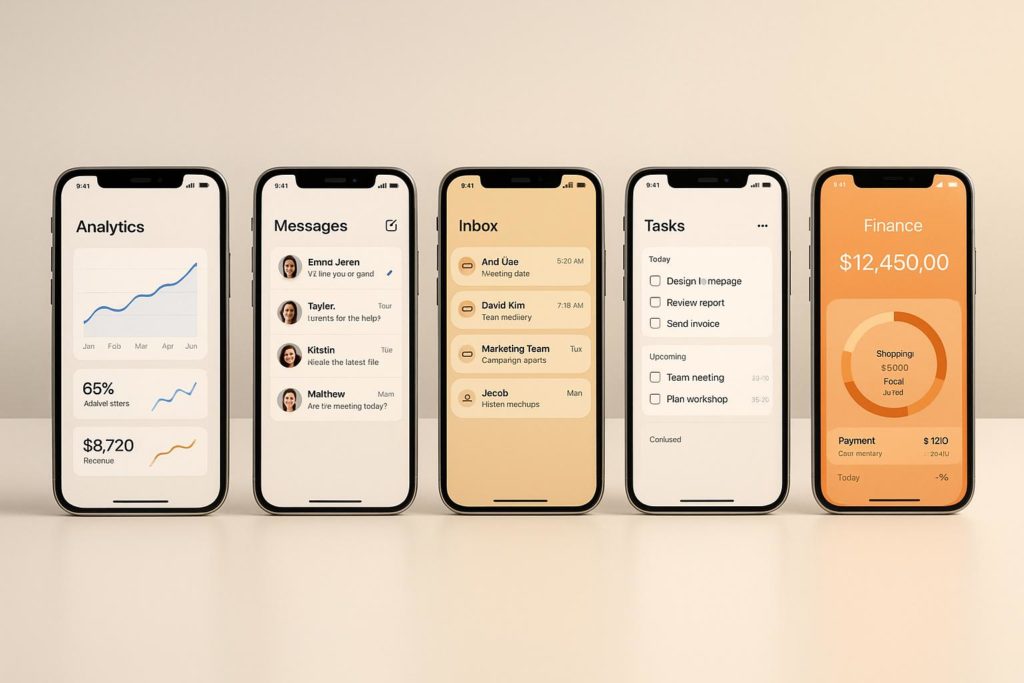Most marketers still treat their company’s app as an afterthought. It sits quietly on the App Store, updated once in a while, mentioned in a footer link, and then forgotten.
But smart brands have realised something powerful: a mobile app isn’t just a product. It’s a marketing channel that drives engagement, loyalty, and sales, without relying on social algorithms or paid ads.
And when you apply App Store Optimization (ASO) properly, that app becomes a growth engine that keeps delivering even when other channels slow down.
“Organic app downloads now account for 65% of total installs, and ASO remains the single most cost-effective acquisition strategy.”
– Data.ai Mobile App Trends Report, 2025
We’ve seen businesses at AppInstitute use ASO to turn stagnant apps into steady streams of qualified users, often without increasing their ad spend by a single pound.
If you’re ready to stop treating your app like a side project and start using it as a marketing asset, this guide is your starting point.
![]()
What Exactly Is ASO?
ASO, or App Store Optimization, is the process of improving your app’s visibility and conversion rates in the app stores – mainly the Apple App Store and Google Play.
It’s the mobile equivalent of SEO. The goal isn’t just to rank high for keywords, but to attract the right audience and convince them to download.
ASO covers three main areas:
-
Visibility – Helping users find your app through keywords, titles, and metadata.
-
Conversion – Turning impressions into installs through visuals, reviews, and trust cues.
-
Retention – Keeping users engaged so positive ratings and active usage sustain your rankings.
“Apps with strong ASO fundamentals generate up to three times more organic downloads than those relying on paid campaigns.”
— Sensor Tower, 2025
Why ASO Matters in 2026
Marketing costs are rising, organic reach on social media continues to fall, and privacy restrictions are tightening.
Meanwhile, the app stores remain one of the last direct discovery platforms left – people are searching for what they want, and your app can be the answer.
Here’s what makes ASO especially relevant now:
1. Zero-Algorithm Dependence
You control your listing. Once it ranks, it stays discoverable without daily content posting or ad bidding wars.
2. Own Your Data
App analytics are first-party. Every install, every retention metric, every purchase belongs to you.
3. Sustained ROI
Unlike ads, ASO gains compound over time. A single optimisation can keep driving downloads for months or years.
At AppInstitute, we’ve watched independent cafés, gyms, and event brands build sustainable user bases simply by improving their app descriptions, visuals, and keywords.
It’s the kind of marketing work that pays off quietly in the background.
How App Store Algorithms Work (in Plain English)
Both Apple and Google want users to find quality apps that they’ll enjoy and keep using. That means their algorithms reward:
-
Relevance – Do your title and keywords match what users search for?
-
Engagement – Do people open and use your app after downloading?
-
Quality – Are your ratings and retention strong?
-
Conversion rate – When people see your page, do they actually install?
Your job with ASO is to send positive signals for all four of these areas. The more consistently you do it, the higher your ranking climbs, and the longer it stays there.

App Feature Comparison Tool Made Easy
Core Components of Effective ASO
Let’s break down the essentials step by step.
1. App Name and Title
This is the most important piece of ASO. Your title needs to include your brand name and one or two main keywords that describe your app’s purpose.
Example:
“BeanPoint – Coffee Shop Loyalty & Rewards App”
Apple allows 30 characters, Google Play allows 50. Use them wisely.
Tip from our experience:
Shorter titles that sound natural perform better. Over-stuffing with keywords looks spammy and can hurt conversion.
2. Subtitle and Short Description
Think of this as your elevator pitch. It should highlight your app’s value in plain language.
Example:
“Order ahead, collect points, and get rewarded with every visit.”
Include one or two secondary keywords here, but keep it human – people read this before they download.
3. Keywords and Metadata
Both app stores index keywords from specific fields in your app listing. Use tools like AppTweak, Sensor Tower, or MobileAction to find terms with good search volume but low competition.
Update your metadata every few months to reflect new trends, seasonal content, or features.
We’ve seen app owners double organic downloads simply by adjusting keywords quarterly instead of once a year.
4. App Icon and Visuals
Your icon and screenshots act like digital packaging. They instantly communicate quality.
Best practices for 2025:
-
Simple, recognisable icon with strong contrast.
-
First screenshot should tell a story, not just show a menu.
-
Use captions on each image to highlight benefits: “Earn rewards,” “Book instantly,” “Get exclusive offers.”
-
Add a short video preview – apps with preview videos get up to 35% higher conversions.
We’ve seen restaurants using dynamic preview clips (made in Canva or Runway ML) lift downloads by 20% within a month.
5. App Description
The long description influences both ranking and conversion.
Structure it for scanning:
-
Start with your core value: what problem does your app solve?
-
Include keywords naturally within sentences.
-
Use bullet points for key features.
-
End with a clear call to action: “Download today to start earning rewards.”
Include social proof if you have it:
“Trusted by over 10,000 daily customers” or “Rated 4.8★ for service.”
6. Ratings and Reviews
User ratings carry enormous weight. Apps with an average rating below 4 stars struggle to rank at all.
Encourage happy users to leave reviews after positive moments in the app – for example, right after a purchase or reward redemption.
Stat:
“An extra half-star in average rating can increase download conversion by up to 25%.” – AppFollow, 2025
At AppInstitute, we’ve built one-tap review prompts into many client apps. It’s the easiest win in ASO.
7. Retention and Engagement
ASO doesn’t end at install. Retention affects rankings too. If users uninstall quickly, the algorithm assumes your app isn’t delivering value.
Keep them engaged through:
-
Push notifications for updates or offers.
-
Loyalty points and achievements.
-
Regular content refreshes.
We’ve seen app engagement lift retention by 40% when businesses use automated push campaigns inside their AppInstitute apps.

Advanced ASO Strategies for 2025
Once you’ve nailed the basics, these advanced tactics can help you stay ahead.
A/B Testing on Store Listings
Experiment with different icons, screenshots, and descriptions. Google Play’s built-in testing tools make this easy.
Test one element at a time and give each test at least two weeks to collect data.
Leverage Seasonal Updates
Refreshing your visuals for holidays, local events, or product launches signals active development.
Both users and algorithms love seeing apps that evolve.
Optimise for Voice Search
With the rise of voice assistants, users now search using full sentences like “app to order coffee near me”. Include natural-language phrases in your metadata.
Track Metrics that Matter
Monitor your:
-
Retention
-
Ratings trends
Tools like App Annie, Adjust, or AppInstitute’s integrated dashboard help visualise these in one place.
Combining ASO with Paid Growth
ASO and paid campaigns work best together. Use ads to drive short-term installs, which improve your store metrics, then let ASO sustain that momentum organically.
A solid strategy looks like this:
-
Launch with a small paid burst to build early volume.
-
Collect ratings and reviews quickly.
-
Refine your ASO elements based on real user data.
-
Maintain consistent engagement so rankings don’t slide.
We’ve seen this hybrid approach double app visibility for small brands within 60 days.
ASO and the AppInstitute App Builder 2.0
With the new AppInstitute App Builder 2.0 (launching November 2025), ASO is baked into the creation process.
You’ll be able to:
-
Auto-generate keyword suggestions using AI.
-
Preview your store listing for iOS, Android, and PWA in one view.
-
Optimise metadata directly from your dashboard.
-
Sync analytics so you can track installs, engagement, and retention all in one place.
We built this because too many great apps never reach their audience – not due to lack of quality, but lack of visibility.
App Builder 2.0 makes sure every app you launch is fully optimised from day one.
Common ASO Mistakes to Avoid
-
Keyword stuffing – It hurts readability and conversion.
-
Ignoring screenshots – They’re your strongest selling tool.
-
Never updating metadata – Stale listings slide in rankings fast.
-
Neglecting retention – The algorithm notices uninstalls.
-
Relying only on paid installs – Organic momentum is what lasts.
What We’ve Learned from Helping 150,000+ Businesses Build Apps
After more than a decade in the no-code app space, we’ve learned that successful ASO isn’t about tricking algorithms. It’s about understanding people.
-
The apps that perform best solve a clear problem and communicate it simply.
-
Great visuals matter more than technical specs.
-
Consistency beats one-off optimisations.
-
Engagement metrics (DAU/MAU, retention) now influence ASO more than ever.
We’ve seen small coffee shops rank above major chains locally simply because they invested time in getting their app listing right.
ASO is the digital equivalent of curb appeal – it gets people through the door so your app can do the rest.
The Future of ASO: Smarter, Predictive, and AI-Driven
ASO is becoming more dynamic. Algorithms are learning from behavioural data, not just text fields.
Here’s what’s next:
-
AI keyword generation that adapts automatically to search trends.
-
Personalised app store listings that change based on user profile or location.
-
Integration with LLMs (large language models) to summarise reviews and generate optimised copy in real time.
At AppInstitute, we’re already testing these features in our 2.0 builder to help creators stay ahead of every shift.
Final Thoughts on App Store Optimization 2026
If your brand has an app, it’s time to stop thinking of it as a side project.
Your app is your most direct, most owned marketing channel – no algorithms, no middlemen, just your audience.
ASO is how you make that channel visible and sustainable. It’s SEO for the app world, but with stronger returns and less competition.
Start small: refresh your title, update screenshots, encourage reviews, and track engagement weekly.
The compound effect over time will surprise you.
“We’ve seen brands that actively optimise their store listings grow organic installs by 150% year over year – all without increasing ad spend.”
-AppInstitute Internal Data, 2025
ASO isn’t a one-off project. It’s an ongoing habit that turns your app into a living, breathing part of your marketing ecosystem.
And with tools like AppInstitute’s App Builder 2.0, that habit just became easier – and a whole lot smarter.
Last Updated on November 9, 2025 by Becky Halls
0 thoughts on “App Store Optimization (ASO) in 2026”